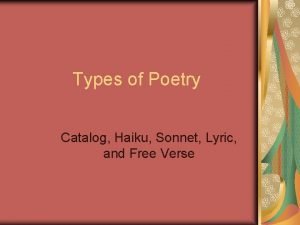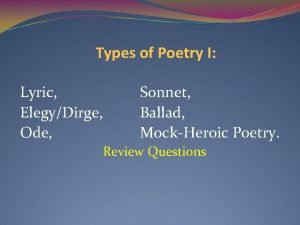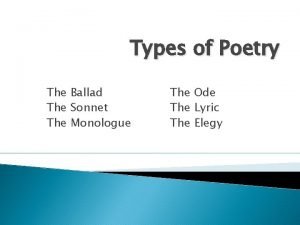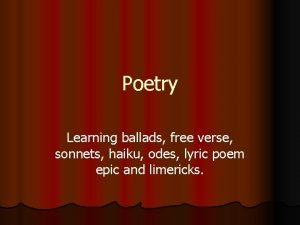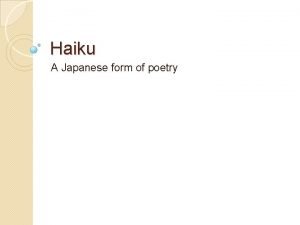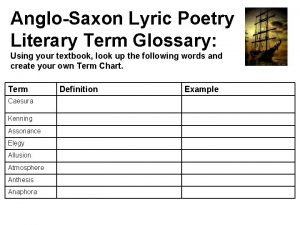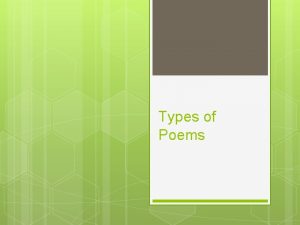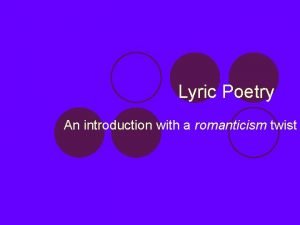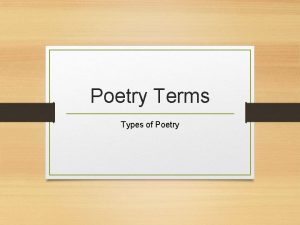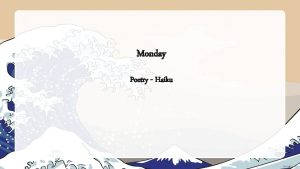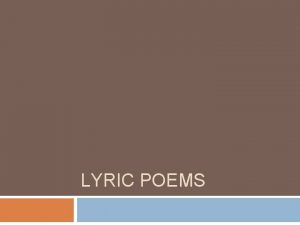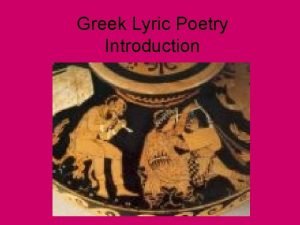Types of Poetry Catalog Haiku Sonnet Lyric and













- Slides: 13

Types of Poetry Catalog, Haiku, Sonnet, Lyric, and Free Verse

Catalog Poem Like a catalog of clothes you get in the mail, a catalog poem has a list of items, actions, etc. that relate to the title. A catalog poem may follow a rhyme scheme, but does not have to. It is basically a long list. Examples: “Woman Work” and “Daily”

Haiku is a structured Japanese poem that conveys strong images. Format: It has seventeen syllables total: five in lines 1 and 3, seven in line 2. It often presents images from nature and everyday life. It often presents a moment of discovery or enlightenment. It often has a “kigo, ” a seasonal word or symbol.

Haiku Example: Get out of my road (5 syllables) and allow me to plant these (7 syllables) bamboos, Mr. Toad. (5 syllables) Miura Chora I show my students (5 syllables) How to read, write, and study. (7 syllables) I hope that they learn. (5 syllables) Ms. Collie

Writing Your Haiku You need to have at least two haikus on your haiku page. Start by thinking about an image or discovery that you want to convey. Write each line following the structure of syllables. You can choose if you want your lines to rhyme or not.

Sonnet A sonnet has fourteen lines and a regular rhyme pattern (scheme). It is written in iambic pentameter. There are two types of sonnets: Italian/ Petrarchan English/ Shakespearean

What is iambic pentameter: An iambic foot is an unstressed syllable followed by a stressed syllable. We could write the rhythm like this: da DUM A line of iambic pentameter is five iambic feet in a row: da DUM da DUM

Italian/ Petrarchan Sonnet The first eight lines (octave) introduce a problem. The last six lines (sestet) respond to the problem. Example: Wordsworth’s “The World”

Italian Sonnet Example “The World” by William Wordsworth (8)The world is too much with us; late and soon, A Getting and spending, we lay waste our powers: B Little we see in nature that is ours: B We have given our hearts away, a sordid boon! A The sea that bared her bosom to the moon; A The winds that will be howling at all hours, B And are up-gather'd now like sleeping flowers; B For this, for everything, we are out of tune; A (6) It moves us not- Great God! I'd rather be C A Pagan suckled in a creed outworn: D So might I, standing on this pleasant lea, C Have glimpses that would make me less forlorn; D Have sight of Proteus rising from the sea; C Or hear old Triton blow his wreathed horn. D

English/ Shakespearean Sonnet You have three four-line stanzas (known as quatrains). Then you have a couplet. Example: “Sonnet 18” by William Shakespeare

English Sonnet Example “SONNET 18” by Shakespeare Shall I compare thee to a summer's day? A Thou art more lovely and more temperate: B Rough winds do shake the darling buds of May, A And summer's lease hath all too short a date: B Sometime too hot the eye of heaven shines, C And often is his gold complexion dimm'd; D And every fair from fair sometime declines, C By chance or nature's changing course untrimm'd; D But thy eternal summer shall not fade E Nor lose possession of that fair thou owest; F Nor shall Death brag thou wander'st in his shade, E When in eternal lines to time thou growest: F So long as men can breathe or eyes can see, G So long lives this and this gives life to thee. G

Lyric Poetry A lyric poem is a short poem that expresses a speaker’s thoughts or feelings. Lyric poems were originally performed in ancient Greece to the music of a lyre. That is where we get the title song lyrics today!

Free Verse Poetry that is “free” of strict patterns of rhyme scheme and meter. It is poetry because of its clearly focused images, figures of speech, and careful diction. Free verse if “free” of strict patterns of rhythm, but is still has a rhythm based on the natural rise of fall of our voices and repetition of sounds, words, and phrases. Example: “The Gift” on p. 469 in your textbook.
 Haiku sonnet
Haiku sonnet Elegy poem examples
Elegy poem examples Sonnet lyric poetry
Sonnet lyric poetry Poem vs sonnet
Poem vs sonnet Sonnet lyric poetry
Sonnet lyric poetry Narrative poems by shel silverstein
Narrative poems by shel silverstein Ballad haiku poetry sonnet
Ballad haiku poetry sonnet A poem that tells a story *
A poem that tells a story * Haiku poems
Haiku poems Types of poetry haiku
Types of poetry haiku Fourteen line lyric poem
Fourteen line lyric poem Lyric poem literary definition
Lyric poem literary definition Ballad characteristics poetry
Ballad characteristics poetry Element of lyric poetry
Element of lyric poetry
